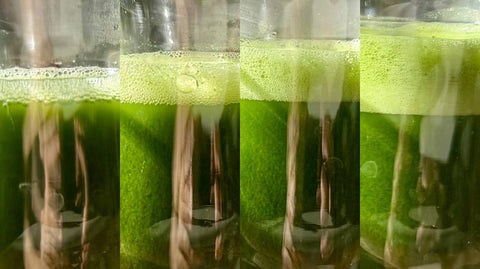
Microfoam’s Surprisingly Big Role in Matcha
Community Content, by Audrey Lee
Audrey started drinking matcha in 2019 and started @matchastgrm to share and document her thoughts and tasting notes. For her, matcha preparation offers a therapeutic outlet, bringing a sense of calm to her day. With a background in science, she approaches matcha with an experimental spirit. When not whisking matcha, her hobbies include homebrew, baking, appreciating teaware and pretty rocks.
My initial foray with changing microfoam
When I first started exploring matcha, my goal was always to whisk it to perfection: achieving the glossiest, frothiest foam. As I gained more experience, I became more proficient at it: the hand movement as well as combining vigorous and slow surface whisking. For a while, glossy, frothy microfoam became my default way to whisk.
One day, feeling a little lazy, I casually whisked my matcha and ended up with a coarse foam. I skipped the usual slow whisk to smooth out the bubbles; I whisked it together briefly and tried it. To my surprise, it tasted noticeably different from the glossy microfoam matcha I usually make, even though I was using the same powder. The flavour was stronger and bolder. The only thing I had changed? The amount of air and effort I put into whisking.
From then on, whenever I found usuchas too mild or wanted a stronger flavor, I started aiming for a coarser, thinner foam. This inspired me to conduct a side-by-side comparison to explore how foam impacts the flavour of a matcha.
Side by side comparison of 4 usuchas
Brewing each Usucha
Each usucha was made with 1.5 g of matcha and 50 ml of 85 °C water. The same matcha powder was used for all usuchas. When the matcha powder settled at the bottom (which inevitably happens for all usuchas), a quick stir was given to redistribute the matcha powder evenly.
Foam levels:
1. No foam
Whisking this was unnatural for me. My instinct is to whisk vigorously in the first few seconds to aerate, but doing slower motions to mix the matcha powder seemed to distribute the powder evenly enough.
2. Thin and partial foam
Whisk gently in a back and forth motion until the foam covers approximately half of the surface and ponds of green matcha remain, then gently even out the larger bubbles with some surface whisking. This style of whisking is often referred to as “pond” style, practiced by the Omotosenke tea school.
I whisked to a pond-style matcha. However, when poured into the tasting glass, the smaller diameter of the cup caused the foam to stack, creating the impression of a taller, denser layer. However, you can still see how the size of the bubbles is more varied compared to a more consistent and fine foam of usucha 3 and 4.
3. Medium and full foam
Whisk for longer until the foam covers the entire surface, then gently even out the large surface bubbles. The foam texture is similar to a latte.
4. Thick and fine microfoam
This is how I usually whisk my matcha: whisk vigorously until very foamy, then slow down to a medium speed of whisking, and finally slow surface whisking to achieve a fine microfoam. This style of whisking is practiced by the Urasenke tea school. This foam texture is similar to a cappuccino.
Observations
|
Usucha 1: |
Usucha 2: |
Usucha 3: |
Usucha 4: |
|
|
Top view |
|
|
|
|
|
Side profile |
|
|
|
|
|
Texture |
2/5 Flat, similar to a loose leaf tea |
2/5 Similar to No foam |
3.5/5 Medium body |
4/5 Fullest body |
|
Bitterness |
0.5/5 |
1/5 |
0.5/5 Very slight |
0/5 None detected |
|
Astringency |
0.5/5 Very slight |
1/5 Strangely, most astringent |
0.5/5 Very slightly astringent |
0/5 None detected |
|
Body and aftertaste |
1.5/5 Light-bodied, smooth, and clean but no particular lingering aftertaste (Clean cold brew refreshing tea) |
2/5 Light-medium bodied, not as smooth, slight lingering aftertaste |
2.5/5 Medium-bodied, Lingering creamy, semi-sweet vegetal, herbal aftertaste |
3/5 Medium-bodied, |
|
Aroma |
2/5 |
1.5/5 |
1/5 |
0.5/5 Mild aroma |
|
Nutty, roasted notes |
2/5 |
1.5/5 |
3.5/5 Nutty, peanut roasty but not as much as Usucha 4 |
4/5 Most nutty, notes of dark chocolate. |
|
Vegetal, fresh notes |
2.5/5 A cleaner, smoother green vegetal flavour compared to Usucha 2. |
3/5 Vegetal grassy notes are most prominent here |
1.5/5 Vegetal notes are stronger than Usucha 4 but weaker than Usucha 1. |
0.5/5 Vegetal notes not very prominent |
|
Perception of Umami-ness |
2.5/5 Umami was not very strong, taste was overall very smooth, and was mild in comparison to the others |
3/5 Umami was present but was not its most forward quality; bitterness and astringency were more prominent in comparison to the others |
4/5 Umami present in a more nutty herbal/vegetal/brothy soup |
4/5 Umami present, but emphaised more in a sweet, nutty french fry, dark chocolatey |
|
Perception of Sweetness |
1.5/5 |
1.5/5 Not particularly sweet, but bitterness and astringency were more prominent in this case |
2.5/5 |
3/5 Longest aftertaste and develops into a dryish sweet aftertaste |
|
Personal rating |
3rd |
4th |
2nd |
1st |
Foam for thought?
I found that I had to stir more frequently to re-suspend the matcha powder in Usucha 1 and 2 than in Usucha 3 and 4. The final sips of Usucha 1 and 2 were more intense than Usucha 3 and 4. In this experiment, I tried to resuspend any matcha by stirring before tasting, but this highlights foam’s ability to keep matcha powder in suspension, ultimately facilitating a more consistent flavor profile.
The differences in flavor are certainly noticeable in a side-by-side comparison. I expected Usucha 1 (no foam) to taste the most intense, but it ended up surprisingly mellow! My hypothesis is that, since there was no foam to give the matcha some body and grip, the flavors came across as more mild, flat, and generally mellow. The taste profile was more similar to a clean, cold-brewed loose leaf tea.
Usucha 2 (thin and partial foam) was the most intense out of the 4 usuchas. I think that the slight foam provided just enough body and grip to accentuate intense notes, such as vegetal herbal flavors, bitterness, and astringency. Therefore, the perception of all flavours was stronger and deeper than usucha 1, but more mellow than 3 and 4. The intensity of these other flavours may mean that umami present was no longer the most forward quality, which is why the perception of umami-ness is lower than usucha 3 and 4. While Usucha 2 was certainly not unpleasant, I personally prefer a smoother and more balanced profile.
I was also pleasantly surprised that between Usucha 3 and 4, foam can change the prominent notes of matcha (from vegetal to nutty) while still maintaining the same level of perception of umami-ness! Usucha 3’s slightly thinner foam emphasised more vegetal notes, resulting in an overall vegetal, buttery profile compared to Usucha 4’s nuttier profile. Retrospectively, I do think that all Usuchas presented equal amounts of umami, but how strong umami is perceived would depend on the strength of other flavour components.
Usucha 4 also had the longest aftertaste, which I believe is attributed to how foam provides that extra grip and clings to your mouth. It allows for flavour development even after swallowing, prolonging the sweet-umami aftertaste.
Main takeaways:
From this experiment with this particular matcha, a finer foam created a more mellow and creamy mouthfeel and emphasized nutty notes, as well as creamy notes such as dark chocolate. In my experience, creamy notes are associated with milk chocolate, dairy, butter, or soy milk. Lesser, coarser foam emphasised fresher, more herbal and vegetal notes with some bitterness and astringency.
Of course, different matchas have different flavour profiles, so foam will have different effects on flavor, and the trend of more foam equals less intensity may not hold true to all matcha powders. Moreover, there are a lot of factors that could influence the resultant taste: water temperature, water hardness, freshness of powder, type of chasen, and even the shape of chawan!
I would like to emphasize that bitterness and astringency are not villainous qualities. I do think that a balanced amount of bitterness and astringency could work really well to create a complex and enjoyable matcha. However, my personal preferences lie in something more smooth and balanced.
Foam also adds body to your matcha and, in this particular case, accentuates the pleasant sweet-umami aftertaste. I think foam is analogous to the stronger, more full-bodied experience of red wine compared to a milder, lighter-bodied white wine. Foam allows the flavor to keep developing, even after swallowing. This lingering aftertaste can be either a pro or a con, depending on how pleasant the aftertaste is.
Foam also traps the matcha and aroma. When you first begin whisking, the matcha aroma is quite strong; however, once you establish a foam, most of the matcha aroma is sealed in. While the matcha used in this experiment was not particularly aromatic, if your matcha is highly aromatic, this may be something to take note of.
There is no correct way or amount of foam. How much you choose to foam is completely up to what you enjoy! For those who have been preparing their matcha in a particular way for a while, I encourage everyone to try this for yourself. Altering foam is an easy way to change the tasting experience and add some novelty to your matcha routine.
In conclusion, foam suspends the matcha, enhances mouthfeel, and accentuates different flavor notes, subtly altering the tasting experience. However, matcha quality still reigns supreme—no amount of microfoam can mask the flaws of an unbalanced matcha.
